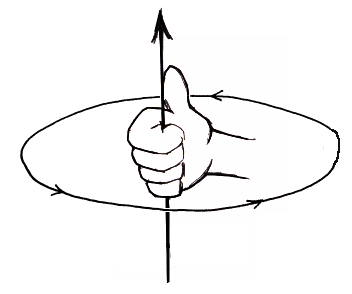

In three dimensions, a particle can have angular momentum. Angular momentum is most often associated with rotational motion and orbits. For a single particle, we define the angular momentum L of a particle about an axis as as L = mr2ω, where r is the perpendicular distance of the particle from the axis of rotation and ω is its angular speed, in radians/s. The direction of the angular momentum is specified using the right-hand rule. If the fingers of your right hand are curling to indicate which way the particle is moving about an axis, then the thumb of you right hand is pointing in the direction of the axis of rotation. This is the direction of the angular momentum.

| Quantum mechanics
predicts that
all angular momentum is quantized in magnitude as
well as in direction.
If we measure the magnitude of the angular momentum, we will only measure discrete values, and if we choose a coordinate system and measure its projection along one of the coordinate axis, we will only measure discrete values. |
||
| Orbital angular momentum is
quantized.
The possible values that we can measure for the square of the magnitude of the orbital angular momentum are L2 = l(l + 1)ħ2. The possible projections we can measure along any axis, for example the z-axis are Lz = mħ. Here l is an integer, l = 0, 1, 2, ... , and for a given l, m can take on values from -l to l in integer steps. The orbital angular momentum can be visualized in terms of a vector model. The angular momentum vector has the magnitude L = (l(l+1)ħ2)1/2, but only a maximum value of lħ can be measured along a given direction, and the possible outcomes of projection measurements are mħ. Lx, Ly, and Lz are incompatible observables and cannot be known simultaneously. If we measure the component of the angular momentum along one axis, we loose information about the components along the other axis. We do, however, not loose information about the magnitude of the angular momentum. Example: Assume we have measured the magnitude of the
orbital angular momentum and found L = (l(l+1))1/2ħ with l =
2. Then the magnitude of the angular momentum vector is L = 61/2
= 2.45ħ. If we measure Lz = 2ħ, then we know that L lies on a cone, as shown on the right, but we do not know its projections along the x and y axes. |
|
|
Problem:
We have measured the square of the orbital angular momentum of a particle and have found the value L2 = 30ħ2. If we now measured the z-component of the orbital angular momentum Lz, what are the possible outcomes of the measurement?